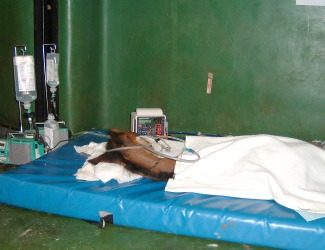Diagnosis and prevention of thrombotic complications in neonate foals

Septicemia is one of the most common clinical conditions in equine neonates. Hypercoagulation or DIC are possible complications of septicemia that has been reported in human and veterinary medicine.
In the last years, several hemostatic and hypercoagulation markers have been assessed in order to improve the diagnosis of hypercoagulation and DIC in subclinical stages. D-dimer, a fibrin-linked degradation product, has demonstrated a good specificity for diagnosis of thromboembolic disorders and a good prognostic value.
In a severe and uncontrolled septicemia, hypercoagulation causes capillary microthrombi and fibrin deposition, which may be responsible in part of the MODS. Some studies have suggested that incidence of MODS and subsequent death can be reduced by early antithrombotic therapy.
No information about antithrombotic therapy in equine neonates is available except for sporadic case reports.
So, our research was divided in two. First, a prospective study with a group of sick and septic neonates was designed, in order to assess the clinical and laboratorial signs of hypercoagulation and DIC, with special attention to D-dimer plasma concentration.
Second, we want to assess a LMWH (dalteparin) in a group of healthy foals, in order to find out the dose needed and possible side effects of this therapy. A group of healthy neonates was included in a prospective study. They were administered LMWH at 2 different doses for a 3-day-period each, and heparin activity and hemostatic profile were assessed. One of the doses was also assessed in a smaller group of septic patients.
The results obtained confirm that septic foals are at risk of suffering a hypercoagulation state. Plasma D-dimer concentration is useful for the diagnosis of sepsis and prognosis assessment in these patients. LMWH is safe in foals and could be used in the future to prevent thrombotic complications in septic patients.
References
"Diagnosis of hypercoagulation in septic newborn foals and thromboprophylaxis". PhD thesis defended by Lara Armengou, Novembre 2010. Director: Lluís Monreal Bosch.


